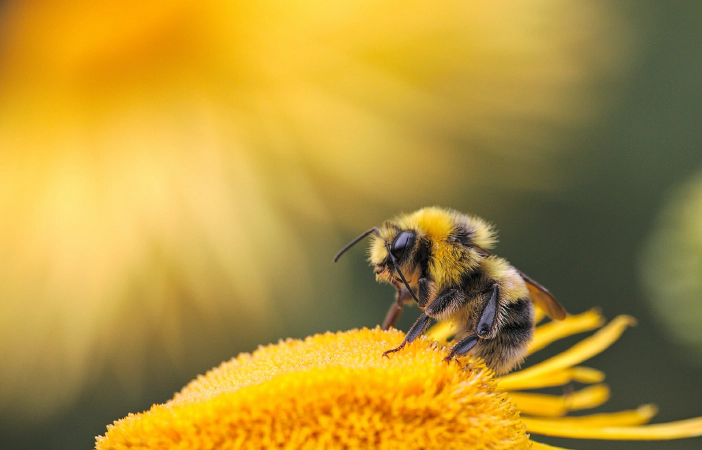
Honey bees have a relatively short lifespan, living for an average of just 5 to 6 weeks.
However, the lifespan of a honey bee can vary depending on factors such as their role within the colony and environmental conditions. Now that we’ve got that out of the way, let’s dive into some interesting facts about honey bee lifespans and what factors can affect how long they live.
Worker Bees
Worker bees, as the name suggests, are the hardworking members of the honey bee colony. They are responsible for a variety of tasks, including foraging for nectar and pollen, cleaning the hive, nursing the larvae, and building and repairing the honeycomb.
The lifespan of worker bees can vary depending on the time of year and the demands of the colony. During the busy summer months, when the colony is thriving and in need of constant care, worker bees have a shorter lifespan of around 5 to 6 weeks.
This is because their bodies are under immense stress from all the work they do, and they simply wear out.
However, during the colder months, worker bees born in the fall have a different fate. These bees, known as “winter bees,” have a longer lifespan of several months.
Their purpose is to ensure the survival of the colony through the winter by clustering together and generating heat to keep the hive warm. These bees are not as active as their summer counterparts, but they play a crucial role in the survival of the colony.
While worker bees may not live as long as some other insects, they make the most of their time by working tirelessly to support the colony. So next time you see a honey bee buzzing around, remember to appreciate the hard work and dedication of these incredible little creatures.
The Queen Bee
The queen bee is the most important member of the honey bee colony. She is responsible for laying eggs and ensuring the survival of the colony.
Unlike worker bees, the queen has a significantly longer lifespan.
On average, a queen bee can live anywhere from 1 to 4 years. However, there have been some exceptional cases where queens have lived even longer.
So what’s the secret to the queen’s longevity?
One factor that contributes to the queen’s extended lifespan is her specialized diet. While worker bees consume a mixture of nectar and pollen, the queen is fed royal jelly.
This nutrient-rich substance gives her the necessary energy and nutrients to produce eggs and maintain her reproductive capabilities.
Another reason for the queen’s longer lifespan is that she is not subjected to the same physical demands as worker bees. The queen spends most of her time inside the hive, laying eggs and being cared for by worker bees.
She is essentially the “queen” of leisure, with her subjects tending to her every need.
It’s important to note that if a queen bee becomes less productive or dies, the colony can raise a new queen. This process involves selecting a young larva and providing it with an increased amount of royal jelly, which will allow it to develop into a queen.
So, while worker bees have a relatively short lifespan, the queen bee reigns supreme with her extended longevity. She plays a vital role in the survival of the colony, ensuring the production of new generations of worker bees and maintaining the harmony of the hive.
Long live the queen!
Drone Bees
Drone bees, unlike worker bees and the queen, have a rather short and unique lifespan. Their primary purpose in the hive is to mate with virgin queens from other colonies and help ensure the survival of the honey bee population.
Drone bees live for approximately 8 to 12 weeks. However, their existence is not as glamorous as it may seem.
Drones do not have stingers or the ability to gather nectar or pollen. They rely solely on worker bees for food and shelter.
During the warm months, drone bees can be seen buzzing around outside the hive, waiting for the opportunity to mate with a queen. Once successfully mated, the drone’s life expectancy decreases significantly.
After mating, the drone dies shortly after, or they are expelled from the hive by worker bees in the late autumn or early winter when resources are scarce.
While the drone bees may not have the same longevity as the queen, their essential role in the breeding process is vital for the propagation of honey bee populations. So, next time you spot a drone bee, appreciate the important part it plays in the intricate life cycle of honey bees.
Worker Bees Born in Fall Live Much Longer
Worker bees born in the fall have a remarkable advantage over their summer-born counterparts - they live much longer. Instead of the typical 5 to 6-week lifespan of worker bees during the busy summer season, these fall-born bees can live for several months, sometimes even up to 6 months or more.
The reason for their extended lifespan lies in the purpose they serve within the colony. While summer-born worker bees are busy gathering resources, nursing larvae, and maintaining the hive, fall-born worker bees have a different task at hand.
As the days grow shorter and temperatures drop, the colony shifts its focus towards survival during the winter months.
Fall-born worker bees become what are known as “winter bees. " These bees go through physiological changes that enable them to withstand the cold and ensure the survival of the colony.
They have increased fat stores, which serve as an energy source during the winter when food is scarce. Winter bees cluster together in the hive, using their body heat to keep the colony warm and protect the queen and other bees.
The extended lifespan of these fall-born worker bees allows them to continue their vital roles during the winter season. Their ability to withstand the cold temperatures and contribute to the survival of the colony showcases the adaptability and resilience of honey bees.
So, while the lifespan of worker bees may be relatively short, the fall-born workers have the unique advantage of an extended lifespan to fulfill their critical roles during the winter months. These bees exemplify the incredible strategies and mechanisms that honey bee colonies have evolved to thrive in various environments and conditions.
